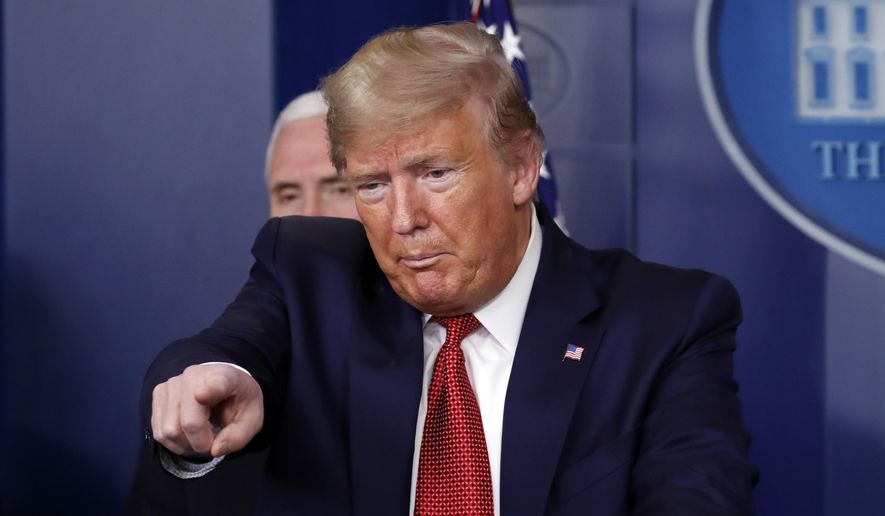OPINION:
When the deadly coronavirus swept across Asia and Europe and then struck the United States with a vengeance, it was very clear to sickened Americans that this was for real.
Clear to everyone, that is, except to President Trump who initially declared the virus “a hoax.”
What followed from the nation’s chief executive, as the virus seeped into each nook and cranny of our nation, was a litany of day to day remarks playing down the threat the disease posed to hundreds of thousands of Americans.
If you want to track how the president responded to the day-to-day crisis, read The Washington Post’s ace fact checker, Glenn Kessler, who reminds us of Mr. Trump’s televised responses from day one on Sunday, March 22.
What he found was that the president “often played down the threats, offering false, misleading or ignorant statements.”
Mr. Trump responded in an interview on Jan. 21, by saying “We have it totally under control. It’s one person coming in from China, and we have it under control. It’s going to be just fine.”
That set of remarks came in an interview with CNBC when he was asked “whether he had any concerns about the pandemic after the Centers for Disease Control and Prevention (CDC) had identified a case of coronavirus in Washington state,” Mr. Kessler reported.
Then in an interview with Fox News host Sean Hannity, on Feb. 2, Mr. Trump told him, “We pretty much shut it down coming in from China.”
The Trump administration “had imposed an entry ban on all foreign nationals who were in the People’s Republic of China, excluding Taiwan, Hong Kong and Macao,” Mr. Kessler writes.
He had been reluctant to impose the ban because of his relationship with Chinese leader Xi Jinping, but was persuaded to do so by his health advisers, Mr. Kessler tells us.
By Feb. 10, at a campaign rally, Mr. Trump said, “Looks like by April, you know, in theory, when it gets a little warmer, it miraculously goes away.” Really?
But when Robert Redfield, director of the CDC, was asked if he agreed that the virus would be gone by April, he told Congress he did not, Mr. Kessler writes.
Then, at a news conference on Feb. 25, Mr. Trump said “We’re very close to a vaccine.” In fact, Mr. Kessler writes, health experts “say a vaccine for this coronavirus is at least a year away from mass distribution, if not longer.”
At a Feb. 26 news conference, the president said “This is a flu. This is like a flu.”
But experts say the “new coronavirus appears to have a much higher fatality rate than the seasonal flu, possibly 20 times higher,” writes Mr. Kessler.
“As you know, Europe was just designated as the hot spot right now, and we closed that border a while ago,” Mr. Trump said at a March 13 news conference.
“Trump did not close the border with Europe,” Mr. Kessler writes. “Only two days earlier, he announced a bar on the entry of foreign nationals who have been to any of the 26 countries in the Schengen area, the European Union’s border-free travel zone — which does not include Britain, the Republic of Ireland and 21 other European countries.”
Then on March 16 Mr. Trump said at a news conference, “We have a problem that a month ago nobody ever thought about,”
In fact, there “were plenty of warnings,” Kessler says. “The Chinese government sealed off the city of Wuhan on Jan. 23 to halt the spread of the virus. And on Jan. 28, two former Trump administration officials published an opinion article in The Wall Street Journal titled, ‘Act Now to Prevent an American Epidemic.’”
That article, Mr. Kessler discovered, “identified a number of steps that needed to be taken immediately, such as partnering with the private sector before the CDC was overwhelmed with testing requests — but it took the administration another month to issue the guidance that would encourage private-sector tests.”
Perhaps the biggest of Mr. Trump’s boasts on March 17 was when he said “I felt it was a pandemic long before it was called a pandemic.”
Mr. Trump “is rewriting history,” Mr. Kessler says. “Just eight days earlier he had tweeted, ‘So last year 37,000 Americans died from the common Flu.’ It averages between 27,000 and 70,000 per year. Nothing is shut down, life and the economy go on … Think about that.”
When Mr. Trump “made that statement at the news conference,” Mr. Kessler points out, the number of confirmed cases had risen to nearly 6,000, with almost 100 deaths.”
Journalists like Glenn Kessler deliver a critical service to our country, protecting us from politicians who play fast and loose with the facts, thinking they can get away with it.
• Donald Lambro is a syndicated columnist and contributor to The Washington Times.




Please read our comment policy before commenting.